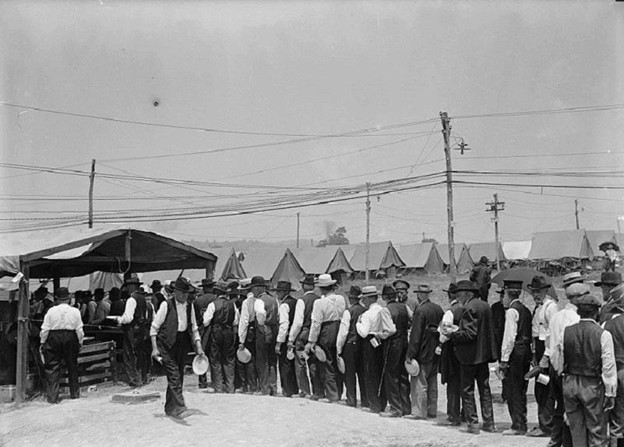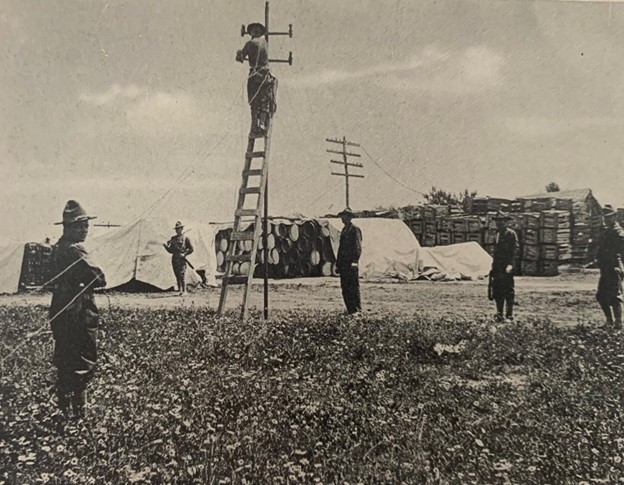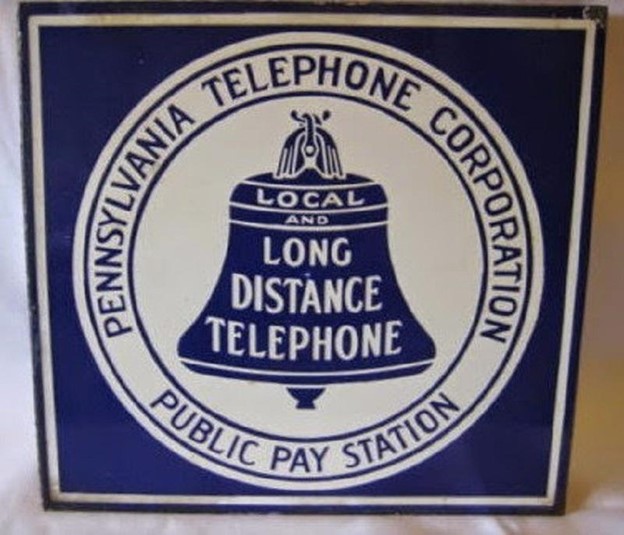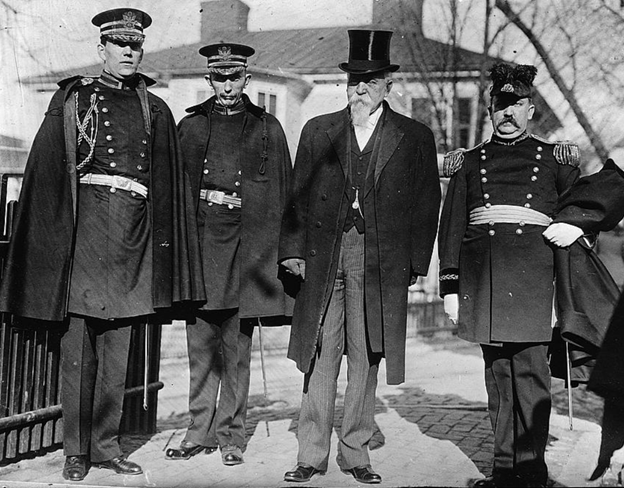Saved by The Bell – The Signal Corps at the 1913 Gettysburg Reunion
Emerging Civil War is pleased to welcome back Richard Heisler of Civil War Seattle
The 1913 Gettysburg reunion was a spectacular achievement in logistics. Converting the small town of Gettysburg and a portion of the adjacent battlefield into a temporary city was a large and complicated undertaking. The temporary tent city housed, fed and provided medical care for over 53,000 aging veterans (with an average age of 72 years) and double that number in visitors.
Those in charge of organizing the reunion operated with the premise that nothing be left undone which might add to the comfort and accommodation of the old soldiers. Work on the camp began weeks before the reunion. Erecting the sprawling tent city itself, the accompanying food and medical facilities, water system and more was successfully accomplished through careful planning and organization. Easily overlooked in the work behind the reunion is a complex communications network that was established by troops of the U.S. Signal Corps.
The Signal Corps men, led by Lieutenant J. G. Taylor, constructed an extensive network that provided telephone communication both within and beyond the vast battlefield encampment. Radiating out from a central office, a network of 87 army telephones and 35 pay stations facilitated the communications needs for those staffing and coordinating the event and also allowed the visiting veterans to make long distance phone calls to family at home.


Telephone information stations were located throughout the camp. The locations of public telephones for local and long-distance use were readily identified by large, blue bell signs of the American Telephone and Telegraph company. The veterans made full use of the accessible phone network. An estimated 8,000 calls per day were made from the camp’s phones over the course of the reunion.

The visiting veterans were not the only ones who made use of the phone lines. Of greater importance was the use of the phones for those involved in the medical needs of the encampment. Rapid communication among those in charge of transportation, logistics and medical care was imperative to the success of the event. Nearly all of the private headquarters of officials in charge of the camp had a telephone installed. Government and military leaders were connected. The hospital rail cars of the State of Pennsylvania Department of Health were directly linked by phone.

The telephone network made communication efficient between the hospitals and aid stations located throughout the camps. The design and layout of the phone lines and call stations was done with that function as its key characteristic. Approximately 100 miles of telephone wire were required. The phone stations were spaced so that the greatest distance any person will have to walk to reach one was, at maximum, 400 feet.
A prompt reaction to any health concern among the camp’s old soldiers was the primary goal. Upon the discovery of a medical situation or emergency, the telephone carried word to the nearest regimental hospital. On call were twelve mule team-drawn ambulances and two motor ambulances, each able to convey six passengers. Within 10 minutes from the time a veteran was found to be ill, he was in the hands of the most efficient medical staff in the government’s service. For the aged veterans in the oppressive heat and humidity, a difference of minutes in reaction and treatment from medical staff could mean the difference between life and death. With the foresight of the reunion organizers and a well-planned telephone system, rapid treatment of stricken veterans saved many lives. More than 740 cases were treated in camp medical facilities, a large majority of them for heat exhaustion or general exhaustion. The system of prompt and efficient communication and care led to a very low mortality rate. Only 8 deaths occurred among the veterans in the camp of the more than 53,000 in attendance, far below any expectations.
Lieutenant Taylor won more than praise for being the architect of the phone system in the encampment. He also gained himself a reputation as something of a sleuth. His speedy communication network could solve problems other than medical emergencies. A colonel on the staff of Virginia Governor William Hodges Mann lost his trunk, and a social function called for a change in uniform. A general alarm was sent out and Lieutenant Taylor found the trunk in the big camp within an hour. Later, a time book of the cooks and kitchen men disappeared. It just had to be recovered. This time, a general alarm was sent out by Lieut. P. H. Bagley, the officer in charge of the railroad and information bureau. Within 35 minutes, the missing book was on Lieutenant Bagley’s desk.

The Signal Corps men did more than just provide and maintain the telephone system throughout the reunion for the veterans and event logistics. They actively participated in the event, as well. A portion of the Signal Corps men was assigned as a detail on Little Round Top. There they operated a demonstration Signals Station that duplicated the US Army Signal Corps transmissions that were sent from that place during the battle in 1863. Records of the Signal Corps communications from the battle were carefully kept, which allowed the signalmen to replicate them exactly 50 years later. Signals such as the following:
Round Top Mountain Signal Station
July 2, 1863.
Capt. Hall:
Saw a column of the enemy’s infantry move into woods on ridge, three miles west of the town, near the Millerstown road. Wagon teams, parked in open field beyond the ridge, moved to the rear behind woods. See wagons moving up and down on the Chambersburg pike, at Spangler’s. Think the enemy occupies the range of hills three miles west of the town in considerable force.
Norton, M.
Taylor, M.
Signal Officers
P.S. -This is a good point for observation.
It is only fitting that it was the veterans of the Signal Corps who performed the closing act of the 1913 reunion. As the reunion closed and the veterans left for home in large numbers, around 100 veteran signalmen of the United States Veteran Signal Corps Association were among those that still remained in the camp. The Signal Corps Association was quite unique among veterans’ groups as its membership contained veterans of both Union and Confederate service. The group had organized its annual association meeting for later that day, to take advantage of the gathering of the membership that was the result of the reunion. Before the signalmen met in the reunion’s Great Tent, there was one task that remained before them.

Signal Corps men during the battle as drawn by Alfred Waud. (Library of Congress)
Following breakfast that morning, the Signal Corps veterans left their tents and moved out onto the battlefield. They carried their “talking flags” and headed to two positions with a commanding view of the entire battlefield. The two “wigwag stations” were soon established. One was near the site of the well-known Signal Corps station on Little Round Top and the other on the opposite side of the field along Seminary Ridge.
The station on Little Round Top was led by veteran Sgt. Charles Dewitt Marcy, of Boston.
In charge of the Seminary Ridge station was veteran Lt. George C. Round, at the time a resident of Manassas, VA. Both were joined by numerous assistants from among the men of the Association. After an exchange of personal greetings, Marcy wigwagged out General U.S. Grant’s immortal words, “Let us have peace.” Translation of it brought forth cheers from the gray-haired veterans, which only increased after Round replied with Lee’s famous declaration, “Duty, the sublimest word in our language.” Another pair of messages was then laboriously spelled out between Little Round Top and Seminary Ridge. “Peace on Earth, Goodwill to Men,“ was sent from Little Round Top by Sergeant Macy. A flag in the hands of Lieutenant Round responded with, “Glory to God in the Highest.”
For more than a week, 50,000 veterans of the war between the states had been peacefully “fighting over again” the scenes of the struggle at Gettysburg and honoring the dead of the Civil War. Before the last veterans dispersed, one final pair of messages traveled between the Union and Confederate lines. “America! All hail to Thee! Thanks be to God, who made us free!” flashed from Little Round Top. From Seminary Ridge, the veterans wigwagged a fitting close to the semi centennial reunion:
“North, South, East and West, hand clasped in hand, United, we the children stand.”
Sources:
Fiftieth Anniversary Reunion of the Battle of Gettysburg Report of the Pennsylvania Commission. Harrisburg PA: Wm. Stanley Ray State Printer, 1915
Gettysburg Times June 13, 1913 p. 1
Tacoma Daily Ledger June 29, 1913 p. 6
Harrisburg Telegraph June 30 1913 p. 7
Harrisburg Telegraph July 5 1913 p.3
Long Beach Press July 5 1913 p.1
Brooklyn Daily Times July 5 1913 p. 1
South Bend News Times July 5 1913 p. 1
Baltimore Sun July 6 1913 p.2
United States. War Department. The War of the Rebellion: A Compilation of the Official Records of the Union and Confederate Armies. Volume XXVII, Part III.Washington :[s.n.], 1894.
A great story!
Thanks for the article and love hearing about the 50th Gettysburg Anniversary! I wonder if it was a coincidence that Lt Round lived in Manassas where the first important wigwag signal used in battle occurred at the Battle of First Manassas/Bull Run by Confederate signal officer E.P. Alexander from Signal Hill to Colonel Nathan Evans – “Look out for your left, you are turned!”
Thanks for this article. So interesting would have been wonderful to be there!
Thanks to the author for presenting this informative back story on the 1913 reunion. While much good feeling characterized this event, let us remember that the themes of “honor” and “duty” helped propagate the Lost Cause narrative that southern veterans, historians and others successfully sold to the nation for decades–that the war was a noble sacrifice in service of “states’ rights,” despite the overwhelming evidence that the south fought to ensure the longevity of slavery.